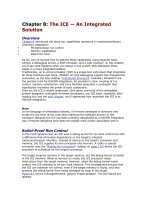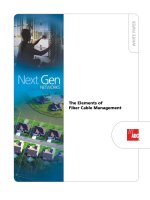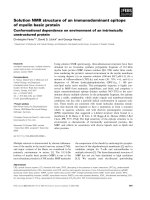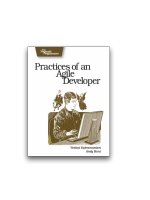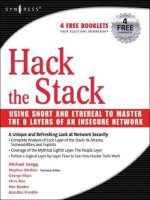Foundational elements of an iot solution
Bạn đang xem bản rút gọn của tài liệu. Xem và tải ngay bản đầy đủ của tài liệu tại đây (6.78 MB, 103 trang )
Hardware
Foundational Elements of an IoT
Solution
The Edge, The Cloud, and Application Development
Joe Biron and Jonathan Follett
Foundational Elements of an IoT Solution
by Joe Biron and Jonathan Follett
Copyright © 2016 O’Reilly Media, Inc. All rights reserved.
Printed in the United States of America.
Published by O’Reilly Media, Inc., 1005 Gravenstein Highway North,
Sebastopol, CA 95472.
O’Reilly books may be purchased for educational, business, or sales
promotional use. Online editions are also available for most titles
(). For more information, contact our
corporate/institutional sales department: 800-998-9938 or
Editors: Susan Conant and Jeff Bleiel
Production Editor: Kristen Brown
Copyeditor: Colleen Toporek
Interior Designer: David Futato
Cover Designer: Karen Montgomery
Illustrator: Rebecca Demarest
March 2016: First Edition
Revision History for the First Edition
2016-03-30: First Release
2016-06-22: Second Release
The O’Reilly logo is a registered trademark of O’Reilly Media, Inc.
Foundational Elements of an IoT Solution, the cover image, and related trade
dress are trademarks of O’Reilly Media, Inc.
While the publisher and the authors have used good faith efforts to ensure
that the information and instructions contained in this work are accurate, the
publisher and the authors disclaim all responsibility for errors or omissions,
including without limitation responsibility for damages resulting from the use
of or reliance on this work. Use of the information and instructions contained
in this work is at your own risk. If any code samples or other technology this
work contains or describes is subject to open source licenses or the
intellectual property rights of others, it is your responsibility to ensure that
your use thereof complies with such licenses and/or rights.
978-1-491-95101-9
[LSI]
Chapter 1. Introduction
The Internet of Things (IoT) has a rich technological legacy and a bright
future: ubiquitous connectivity has created a new paradigm, and the closed,
static, and bounded systems of the past will soon be obsolete. With the
connection of low-cost sensors to cloud platforms, it’s now possible to track,
analyze, and respond to operational data at scale. The promise of the IoT is
indeed wonderful: intelligent systems made up of smart machines that talk
with each other and with people in real time, and data analytics driving
optimization and transformation in industries as varied and far-reaching as
aeronautics and agriculture, transportation and municipal services,
manufacturing and healthcare, and even within our homes.
Building the Internet of Things
The Internet of Things presents exciting opportunities to transform business,
but the specific approaches and patterns remain somewhat ill-defined. So,
maybe it’s not entirely surprising that the recent tidal wave of marketing hype
has engendered some well-deserved skepticism about the IoT’s true business
and social value. Questions about security and fears that such wide-ranging
connectedness will make privacy all but extinct are commonplace. These are
legitimate issues that are being addressed, and will require continuing
maturity of both the business and technology factors if the IoT is to achieve
long-term, broad-based success.
Regardless, it’s clear that, in order to take on the challenges of design for this
new connected world, engineers, designers, technologists, and business
people need to fundamentally shift their thinking. IoT design will be quite
different from design for other complex systems; data will be the critical
material, shared across open and flexible networks. Making the most of IoT
for your business requires strategic thinking and careful planning.
If you don’t quite know where to start with the IoT, you’ve come to the right
place. This guide is for those who have heard both the grand promise and the
skeptical inquiries and nevertheless want to get their boots on the ground.
The guide introduces you to the high-level concepts, components, and
patterns for any type of IoT solution. It will help you to understand the
technology and architecture, so that you, the technologist, can dispel
misconceptions within your organization and assess the opportunities for the
IoT to advance your business. The potential of the IoT may well be limitless
— but in order to get to that promise, we need to get started.
What This Guide Is Not
You’ll find a bevy of other IoT primers on the websites of technology
vendors, standards groups, and industry consortiums, many of them
extremely insightful, but all slightly biased towards either a technology or
philosophical premise about how the IoT should work. There isn’t anything
wrong with these sources, and you are encouraged to check out what they
have to say, but the goal of this guide is to provide you with the real-world
tools and patterns that are in use, or on the near-term horizon, based on
practical hands-on experience in hundreds of IoT solutions over the last
decade. This guide is about what works for the IoT today and what the
considerations are for implementing something right now.
A Technologist’s Definition of the IoT
In 1999, Kevin Ashton of the Massachusetts Institute of Technology (MIT)
coined the term Internet of Things. At the time, industrial automation
technologies were starting to move from the factory into new environments
like hospitals, banks, and offices. This early form of intercommunication
often involved machines of the same type — such as a one ATM machine
talking to another in the same general location — hence the term, Machineto-Machine, or M2M. As early M2M implementations grew increasingly
more sophisticated, machines were connected to other kinds of devices like
servers. Those servers ultimately moved from on-premise locations into data
centers and eventually “the cloud.”
We can appreciate the prescience of Kevin Ashton’s term. Yet while the
“IoT” is a catchy phrase, it doesn’t help us understand the full implications of
this new paradigm. While the Internet is, of course a critical, enabling
element, it is only a part of the essential concept — the idea that we can
connect our reality, part and parcel, to the virtual world of information
systems — that is so truly transformational for smart connected products and
operations alike.
Today, the Internet of Things can include industrial and commercial
products, everyday products like dishwashers and thermostats, and local
networks of sensors to monitor farms and cities. In an IoT solution, objects
can be sensed and controlled through the Internet, whether these objects are
remote devices, smart products, or sensors that represent the status of a
physical location. And information can be made available to applications,
data warehouses, and business systems.
Guide Outline
For some developers, the IoT may seem like a mishmash of technologies
arranged in a bewildering set of combinations. It’s true that this is an area
where embedded computing, MEMs, broadband and mobile networking,
distributed cloud computing, advanced distributed database architectures,
cutting-edge web and mobile user interfaces, and deep enterprise integrations
all converge. But thankfully there are some clean layers that we can use to
inform our mental model of IoT solutions.
Our guide is divided into four chapters:
Chapter 2, Solution Patterns for the Internet of Things
As we tackle other topics in the Internet of Things, it is helpful to think
about recurring architectural patterns — in smart, connected products
versus smart, connected operations, new and innovative experiences,
and so on. The first section of the guide gives you a mental framework
to think about your solution.
Chapter 3, The Edge of the IoT
The edge of the IoT is where all the “Things” reside: from sensors to
vehicles, everyday products to entirely new kinds of gadgets. Our focus
in this section is on how we will connect, secure, and interact with
things from the cloud.
Chapter 4, The Cloud
The cloud, of course, is a critical component of any IoT solution. This
section of the guide outlines the key cloud technologies, design goals,
and implementation details associated with IoT.
Chapter 5, IoT Applications
All our hard work in connecting the edge to the cloud would be for
naught if we didn’t surface information about these “Things” through
software applications. This part of the guide covers ways to get your
applications to market or into the hands of your business quickly and
effectively.
For technologists, the IoT has the potential to be most rewarding; it’s where
hardware, software, and networks bring new solutions to life, bridging the
physical and digital worlds.
Acknowledgments
This book would not have been possible without the contributions of Linda
Frembes, and the O’Reilly editorial team, especially Susan Conant and Jeff
Bleiel. Thank you for all your work.
Chapter 2. Solution Patterns for
the Internet of Things
How do we move from our disconnected world to a new, connected one
where the boundaries between complex hardware and software systems are
blurring? The Internet of Things presents us with design challenges at all
system levels — from overall architecture to device connectivity, from data
security to user interaction — and in the search for solutions, it’s all too easy
to get lost in the forest of standards, technology options, and product
capabilities.
Design Patterns and the IoT
While popular industry verticals like connected health and the connected
home do not map cleanly to implementation approaches, there is another way
of subdividing the space. We can map architectural patterns (spanning
industry verticals) by examining existing, real-world IoT implementations
irrespective of the hardware and software tools used. Let’s identify those —
in the spirit of the Gang-of-Four1 and Christopher Alexander’s Design
Patterns2 — and use that understanding to help us place technical capabilities
in the proper solution context. Throughout this book, as we tackle other
topics related to the Internet of Things, we can use this initial solution pattern
language to build a mental framework that supports other important details.
Pattern Elements
For our general IoT solution patterns, we’ll want some consistent
characteristics with which to evaluate advantages and disadvantages, and
compare and contrast between them. The five elements listed below help us,
as technologists, extract the initial patterns and then analyze real scenarios:
Solution creator
Who designs, engineers, and builds this IoT solution?
Audience
Who buys the solution, and who will use it?
Position in the product/service lifecycle
Is the solution positioned as a product or service that is an end-to-itself
or does it enhance or augment an existing, mature product or service?
Connection
How does the solution connect to the Internet?
Integration
Does the solution require integration with other business or enterprise
systems?
Armed with these characteristics for evaluation, let’s examine three common,
high-level recurring patterns that we see in the real world. Of course, with the
IoT, there are numerous technical patterns and subpatterns we can explore,
but we’ll start with these broad strokes.
Smart, Connected Products
If you’re in your home or office right now, you’re likely surrounded by
machines that you use on a daily basis: from televisions to LCD projectors,
dishwashers to washing machines, ceiling fans to air conditioning units. For
every one of these products, it’s likely technologists are in the process of
connecting them to the IoT, if they haven’t done so already.
The New Product-Consumer Relationship
As the products that we’ve been using for years, perhaps even decades,
become enhanced through connectivity, the nature of the product-consumer
relationship will change in a significant way. Manufacturers will be able to
continually optimize both user and machine interactions through regular
analysis of sensor data. Products will evolve on an ongoing basis, through
their software, and manufacturers will continue to innovate well after the
physical product has shipped. Perhaps most importantly, products will have
features and functions resident in the cloud, outside of their physical
footprint.
This shift has major implications for the product development and
manufacturing lifecycle. In the past, when a product line matured —
characterized by wide adoption but minimal sales growth — manufacturers
attempted to rejuvenate them by adding more features and finding new uses
and audiences.
With smart, connected products, manufacturers have an opportunity to
continually rejuvenate their lines — not only through regular updates, but via
analysis of usage data returning from these machines, making dynamic
customization on a user level possible. This data-driven interplay between
company and consumer alters the product lifecycle to more of an ongoing
flow, a kind of living relationship.3
As technologists, we should consider how a company could be hyperresponsive to users of its products. Smart, connected products offer great
potential for creating ongoing dynamic interaction. For example, consider the
numerous home appliances that can respond to energy cycles, from washing
machines to dryers to dishwashers. Variables, such as the speed of agitation
and the amount and temperature of water or air, can be customized based on
personal usage.
Elements of Smart, Connected Products
Let’s examine the five key elements of smart, connected products.
Solution creator
Product creators of every stripe — from big consumer electronics firms like
Samsung to manufacturers like Deere & Co. to startups like Rest Devices,
who produce the connected Mimo baby monitor — are looking to
differentiate their offerings by giving users more compelling experiences.
Often, this takes the form of features that are only possible by integrating the
product functions with an Internet connection. Samsung’s connected
televisions, for instance, offer applications and programming that are
Internet-based, as well as software updates to improve performance. Deere &
Co., a leader in agricultural machinery, provides farmers with connected
tractors that can be monitored in the field via their JDLink telematics system
(as in Figure 2-1), and the Mimo baby monitor delivers video, audio,
waking/sleep state, and even respiration information to the parent’s
smartphone anywhere in the world.
Figure 2-2 shows the Mimo IoT ecosystem: the “turtle” sensor talks to the
“lilypad” gateway, which in turn transmits data about the infant to the cloud
and eventually, the iOS or Android application. In Figure 2-3, you can see the
Mimo mobile monitoring application, which displays infant position and
respiration data, among other factors that parents can access anywhere on
their smartphones.
Figure 2-1. Monitoring John Deere’s connected tractor in the field (Illustration courtesy Deere & Co.)
Figure 2-2. The Mimo IoT ecosystem (Illustration courtesy Rest Devices, Inc.)
Figure 2-3. The Mimo mobile monitoring application (Photo courtesy Rest Devices, Inc.)
With connected products, manufacturers can collect and analyze usage data
in order to refine future generations of the product. This refinement may
come in the form of better understanding of failure modes so the product
engineers may create a more reliable product, or proactively schedule
maintenance. Or it could mean understanding which features of the product
get the most use, so the product managers and designers can hone in on what
features are working well and what features are being ignored.
Audience
It’s important to understand who buys and uses the smart, connected product.
In the long run, the audience will likely adhere to the same demographics as
those who were buying the previous static, disconnected version. From the
manufacturer’s perspective, however, it’s critical that the effort expended to
design and build that smart, connected product result in meaningful
differentiation and economic rent in the competitive marketplace.
Position in the product/service lifecycle
Typically, these products serve as augmented versions of their disconnected
counterparts, extending the features of the existing product types and
categories that we understand today. However, as the IoT matures, we’ll see
products come to market that could not have been fully realized without an
initial set of connected capabilities.
Connection
Since 2012, the trend has been toward manufacturers designing connectivity
directly into their products. Previously, when manufacturers were interested
in connecting their high-value products — so that, for instance, services
teams could remotely troubleshoot and react to product issues without the
need for an engineer on site — they were forced to retrofit them for the IoT.
Integration
Service monitoring aside, in most instances enterprise and business system
integration for smart connected products is likely to be lightweight, if it exists
at all. However, from the consumer software side, mobile applications, web
portals, and analytics will be high value drivers, along with the function of
the connected product itself. Business system integration, however, could
become a common addition to such products, particularly if initial product
pilots prove solution efficacy.
Smart, Connected Operations
Sometimes the connected “thing” isn’t a single product or device, but rather
an entire operation that can be instrumented and optimized, with access to
real-time system data and control capabilities from the cloud.
Smart, connected operations differ from the aforementioned products in that
they often require retrofitting existing infrastructure with the sensors and
communication modules that make an IoT solution possible. Additionally,
system analytics, artificial intelligence for discovery and autonomous
decision-making, and deep business system integration add a layer of
complexity to connected operations not necessarily seen with individual
products.
Smart, connected operations make a new level of system visibility and
flexibility possible for industries as varied as agriculture, energy,
transportation, and manufacturing. Let’s look at a few examples of these to
further examine the kinds of scenarios and use cases that make up the smart
connected operations pattern.
